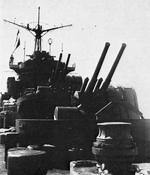Chitose
| Country | Japan |
| Ship Class | Chitose-class Light Carrier |
| Builder | Kure Naval Arsenal |
| Laid Down | 26 Nov 1934 |
| Launched | 29 Nov 1936 |
| Commissioned | 25 Jul 1938 |
| Sunk | 25 Oct 1944 |
| Displacement | 11,400 tons standard; 15,500 tons full |
| Length | 632 feet |
| Beam | 68 feet |
| Draft | 25 feet |
| Machinery | 2 steam turbines, 2 geared turbines, 2 shafts |
| Bunkerage | 3,000t fuel oil |
| Power Output | 56,000 shaft horsepower |
| Speed | 29 knots |
| Crew | 800 |
| Armament | As tender: 4x12.7cm/40 Type 89 guns, 12x25mm Type 96 anti-aircraft guns; as carrier: 8x12.7cm/40 Type 89 guns, 30-48x25mm Type 96 anti-aircraft guns |
| Aircraft | 30 operational, 0 in reserve |
| Conversion | 1942 |
| Recommission | 1 Jan 1944 |
Contributor: C. Peter Chen
ww2dbaseChitose served for the greater part of her career as a seaplane tender at Kure. On 4 Jan 1942, her aircraft covered the Japanese landings at Davao at the Philippine Islands, receiving battle damage. Later that month, she covered the landings at the Dutch East Indies and at the Gilbert Islands. During the Battle of Midway in Jun 1942, she carried seaplanes with the Transport Force with the mission to set up a seaplane base at either Eastern Island of the Midway Atoll or at Kure Atoll, but the mission was canceled due to the American victory during the battle. In Aug 1942, she was damaged during the Battle of Eastern Solomons. In late 1942, she was sent to Sasebo Navy Yard for conversion into a light carrier, which was completed in Jan 1944, and was assigned to Carrier Division 3. On 25 Oct 1944, she was part of Admiral Jisaburo Ozawa's decoy fleet off Cape Engaño in the Philippines as a part of the Leyte campaign. At 0835 that day, she received three hits, either near misses from bombs or submarine torpedoes, on the port side forward of the number 1 elevator. Boiler rooms 2 and 4 were flooded and the ship began to list. By 0855, the list was corrected slightly, but her speed was reduced to 14 knots. At 0930, she was dead in the water and the list increased to 30 degrees. She rolled over to port and sank at 0937.
ww2dbaseSource: Wikipedia.
Last Major Revision: Feb 2007
Light Carrier Chitose Interactive Map
Photographs
 |  |  |  |
Chitose Operational Timeline
| 25 Jul 1938 | Chitose was commissioned into service. |
| 12 Oct 1942 | Yugure and Yura escorted Nisshin and Chitose after Battle of Cape Esperance off Guadalcanal, Solomon Islands. |
| 25 Oct 1944 | Off northeastern Luzon, Philippines, aircraft from US Navy Task Force 38 attacked the Japanese carrier force consisted of fleet carrier Zuikaku and light carriers Zuiho, Chitose, and Chiyoda in the Battle off Cape Engaño. The Japanese force was escorted by two battleship-carrier hybrids (Hyuga and Ise; aircraft-less on this date), three light cruisers (Oyodo, Tama, and Isuzu), and nine destroyers at about 0830 hours, 26 minutes after those planes were detected by Zuikaku's radar. The overwhelmingly larger American force, under Admiral William Halsey, centered around fleet carriers USS Lexington, USS Intrepid, USS Essex, USS Franklin, USS Enterprise, further bolstered by a great many light carriers, battleships, cruisers, and destroyers. Zuikaku was damaged by skilled damage control teams extinguished the fires and corrected the listing by 0850 hours. Chitose was fatally damaged by the first attack wave, sinking at 0937 hours. At 0953 hours, a second attack wave struck, fatally damaging Chiyoda, leaving her dead in the water to be sunk by American destroyers later at 1655 hours. The second wave also damaged Zuiho's flight deck, the last functional flight deck of Vice Admiral Jisaburo Ozawa's force; Japanese combat air patrol planes in the air would need to ditch when they ran out of fuel. At 1032 hours, Ozawa transferred his flag from the damaged Zuikaku to Oyodo. At 1308, the Japanese sighted an incoming third wave of American aircraft. Six torpedoes struck Zuikaku, causing massive flooding and several fires in the hangar; the commanding officer addressed the surviving crew, ordered the lowering of the ensign, and gave the abandon ship order at 1358 hours; Zuikaku sank by the stern at 1414 hours. Zuiho suffered two torpedo, two bomb hits, and a great many near-misses during the third attack wave, and she was dead in the water at 1445 hours. At 1455 hours, a fourth wave struck, sealing the doom of Zuiho with ten near-misses, leading to Zuiho's commanding officer giving the abandon ship order; she sank at 1526 hours. |
Please consider supporting us on Patreon. Even $1 per month will go a long way! Thank you. Please help us spread the word: Stay updated with WW2DB: |
» Inoue, Isamu
Event(s) Participated:
» Invasion of the Philippine Islands
» Guadalcanal Campaign
» Solomon Islands Campaign
» Philippines Campaign, Phase 1, the Leyte Campaign
Document(s):
» Japanese Aircraft Carrier Functions
» Japanese Aircraft Carrier Operational Status By Month
» Japanese Aircraft Carrier Specifications
» Japanese Aircraft Carrier Time Operational
Partner Sites Content:
» Chitose Tabular Record of Movement
- » 1,167 biographies
- » 337 events
- » 44,617 timeline entries
- » 1,244 ships
- » 350 aircraft models
- » 207 vehicle models
- » 376 weapon models
- » 123 historical documents
- » 261 facilities
- » 470 book reviews
- » 28,516 photos
- » 365 maps
Chiang Kaishek, 31 Jul 1937
Please consider supporting us on Patreon. Even $1 a month will go a long way. Thank you!
Or, please support us by purchasing some WW2DB merchandise at TeeSpring, Thank you!